The National Museums Scotland’s exhibition, Bonnie Prince Charlie and the Jacobites, took place in the summer of 2017. One of the costumes on display was a dress ensemble originally owned by Mary Oliphant of Gask (1720 – 1785), whose family were involved in the Jacobite cause. The mantua is reputed to have been worn at the Jacobite Ball of 1745 held in Holyrood, although it may have originated earlier in the 1730s.

The dress is now planned as a rotation piece for future display in our permanent Fashion & Style Gallery. The mantua would originally have had three parts, consisting of a petticoat (or skirts), robe, and stomacher, which in common with other similar outfits, has not survived. The robe and petticoat are made from finely ribbed cream silk embroidered with a balanced design of silk thread fruits and flowers intercut with looped vines in metal threads.

The petticoat is more modestly composed than the huge, elongated style worn at Court in the latter half of the 18th century, but still would have required support with side hoops, also known as panniers, or a wood or cane cage, plus other soft layers. The robe is made from two long loom widths of fabric, joined and shaped at the shoulders, back and waist with pleats; the train is composed of additional panels which form a kite shape, and the sleeves are not set in but sewn over the ground cloth to join at the armholes. The stomacher would have been a triangular piece of lightly padded silk, likely to have been embroidered to match its companion pieces. The robe did not meet in the middle but would have been worn open, with the stomacher pinned or perhaps sewn into place at the centre front during wear.
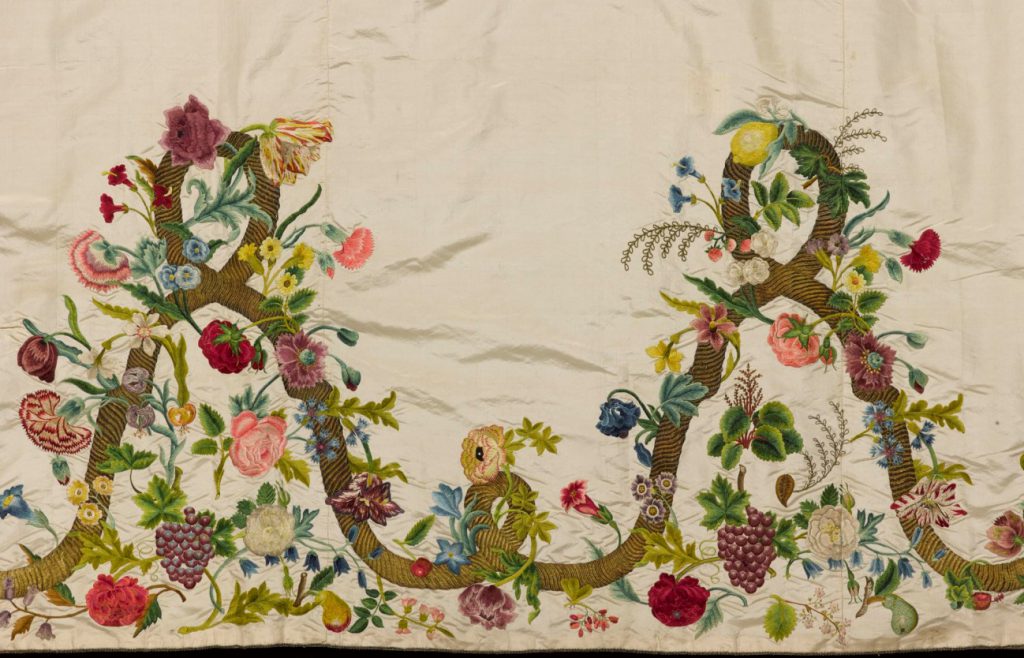
The condition of the Mantua was interesting; in some ways it has survived with fairly minimal damage given its age, particularly the embroidery colours which remain very bright and true although the metalwork is now quite tarnished. There are some small historic repairs and some existing conservation work carried out in the 1990s to support weak areas of silk, which remain stable. Both underarms had had nylon net applied over large holes in the silk, which had served to hold the silk in place but which required replacing with more comprehensive support.
The dilemma

However the outfit had been altered to a larger size. A sign of this was the way the green silk petticoat lining was no longer able to meet the waistband, leaving a raw edge (above). Several inches of lining were exposed at the centre front and back, suggesting the cream silk had been turned up to form a higher waistband. The colour of the cream silk is lighter and brighter above a horizontal crease around the circumference of the petticoat, compared with the somewhat greyer silk below, indicating that the silk had been turned to the inside for some time. There were also vertical creases from previous pleating around the waist with accompanying stitch-holes.
It is very common to find that a historical dress has been altered, particularly rare and beautiful pieces like the Oliphant mantua. Re-sizing can be the reason, but sometimes the changes suggest a style was modified to fit with the silhouette of a subsequent fashion. The huge cost of such dresses, which were rarely worn, made them prime material for adaptation or even for fancy dress. Also they were sometimes altered so that they can be recycled to fit with the silhouette of subsequent fashions, as these dresses were very expensive and rarely worn. This can pose a dilemma – after all, which is the most ‘authentic’ version in the objects’ history? The issue can be clarified with further research into what is already known about the object. In this case various factors meant there were some distinct issues with leaving the alterations in place.

As the mantua had been re-modelled, it was necessary to assess how it fitted when mounted to help decide what to do next. I padded out the mannequin waist first and put on suitable undergarments, but I found the petticoat wanted to hang in a circle, not the more usual ovoid shape of the period, which would inhibit the robe from draping correctly. The enlarged waist was proportionally much wider than the narrow shoulder width suggested it should be, and the two pieces would not fit the same size of mannequin when mounted. The evidence of original construction, appearance of the green silk lining and irregular quality of the newer pleating, alongside discussion with curatorial colleagues at National Museums Scotland and other museums, helped confirm that the original construction should be re-instated.


The first step was to reverse the waist alteration, which was done by snipping stitches and removing the thread with tweezers. As the work progressed the petticoat unfolded, revealing the original creasing pattern more fully and flattening the cloth to an earlier construction stage. The image below shows the panel joined and rudimentary shaping provided for the waist using the seams at the centre front and back to turn back some of the top edge, creating a characteristic ‘v’ shape. I was delighted to be able to see the petticoat in the same form as the dressmakers would have in the 1730s.

In this arrangement, the cloth would be pleated to fit the waist whilst keeping the vine pattern composed with three loops on the front and back skirts. The two slits are pockets. Seeing the petticoat like this was a rare treat, and a great opportunity to see the design spread fully out.

The re-pleating was carried out gradually, working around the waistband noting any vertical creases which crossed the horizontal fold in opposite directions. The image above shows evidence of original (centre) and non-original (far right) fold lines. The original pleat positions were marked with temporary tailor tacks and then re-pleated and re-stitched using previous stitch-holes where possible. The waist edge was also covered with a band of nylon net for additional support. The work of stitching the pleats into place was harder than I had expected due to the extremely fine, tight weave of the silk and its relatively dry condition. Passing a needle through the original holes was hard going at times, and numerous needles were broken in the attempt. That stage of the work took approximately 60 hours.
The petticoat now made much more sense for a mid-18th century garment. An important feature of the fit is the way the front waist pitches downward from the natural waistline as opposed to encircling it, which is a consequence of the original ‘v’ shaped cut and construction. As anticipated and hoped for, the waist circumference was also greatly reduced.

The robe had also been altered and let out at the bust, perhaps changing it from a modern size 6 to a size 16-18. It is unlikely to have fitted too well at the shoulders, but I was grateful they had not been altered. There was somewhat conflicting evidence as to how the bodice was originally made, and though it was clear it had been let out, it was not clear how it would be put back in. For this reason, and due to time constraints, I left this alteration in place.
Support work on the robe armholes was still required though. The net was carefully removed, and new patches of custom dyed silk were inserted behind the hole. With this done, a new custom dyed nylon net was applied over the top of the damaged areas to ensure the whole area was properly stabilised and the historic silk cannot be accidentally snagged; the two layer patch was stitched on using monofilament silk in various conservation stitches.
The stomacher
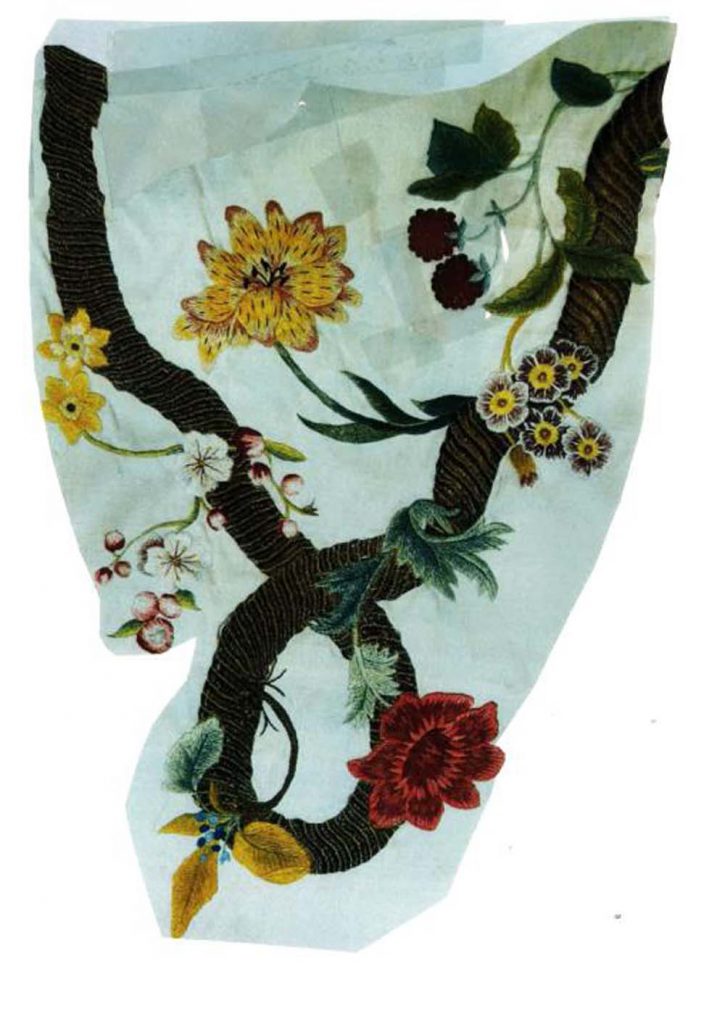
The issue of the stomacher still remained. The most common solution to missing stomachers is to make a substitute; they are straightforward to make and can work well when the fabric is dyed to match the main colour of the dress. Usually they are left plain and unadorned to help distinguish them from the original clothing, but in this case I was concerned that a plain cloth might be difficult to colour match. Natural ageing of textile fibres includes soiling patterns which are not possible to recreate when custom dyeing. Paler colours especially can ‘jump’ and look unsympathetic.
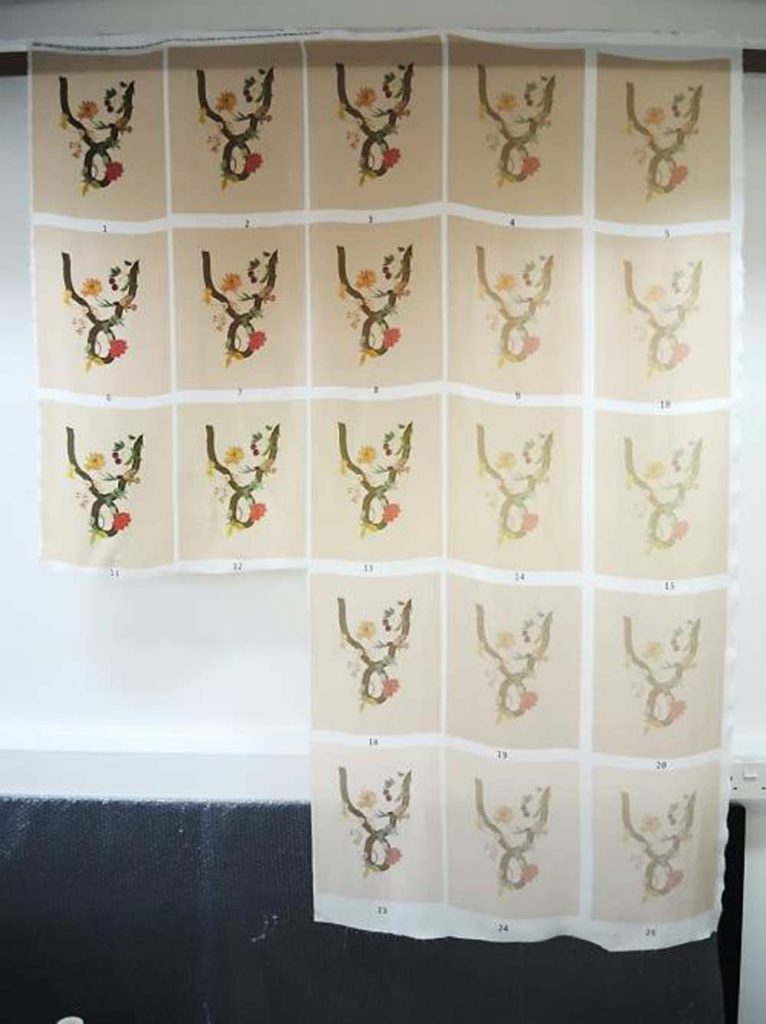
In a previous project, I had worked with Alan Shaw from the Centre for Advanced Textiles at Glasgow School of Art to create a digital patch. This time, I thought it might be possible to make a digital print of the original embroidery onto silk and make a stomacher with that. The intention would be to indicate a matching piece, but be clear with signage that it was not an original item. NMS photographer, Mary Freeman, took some images of the pattern from the robe and I put together a rough cut and paste for Alan to work with. Amazingly he was also able to re-create the varied colour of the ground silk using the images Mary had taken.
Alan printed a run of ‘stomacher silks’, making slight variations to each print with colour saturation, brightness and contrast. We were aiming to create a print which would be slightly more shadowy than the original embroidery to help distinguish it from the original pieces. I chose the most sympathetically matched version to make the stomacher with.
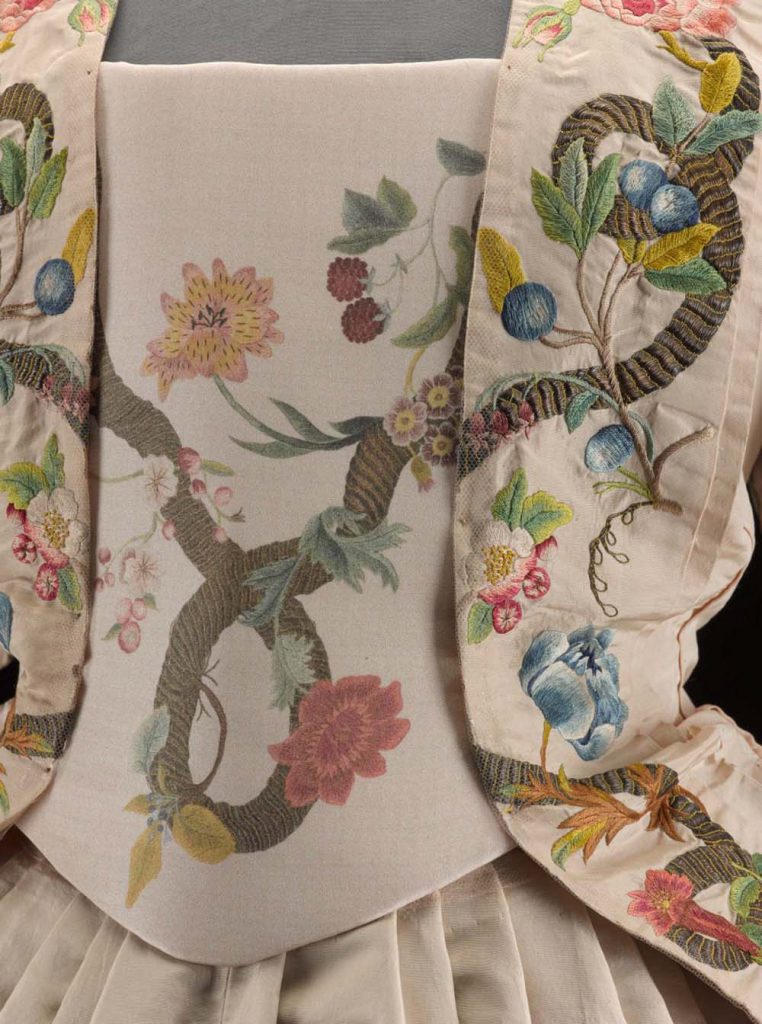
I was very happy with the result and pleased the stomacher was able to blend so well with the robe and petticoat, without looking like it was cut from the same cloth as the mantua itself.
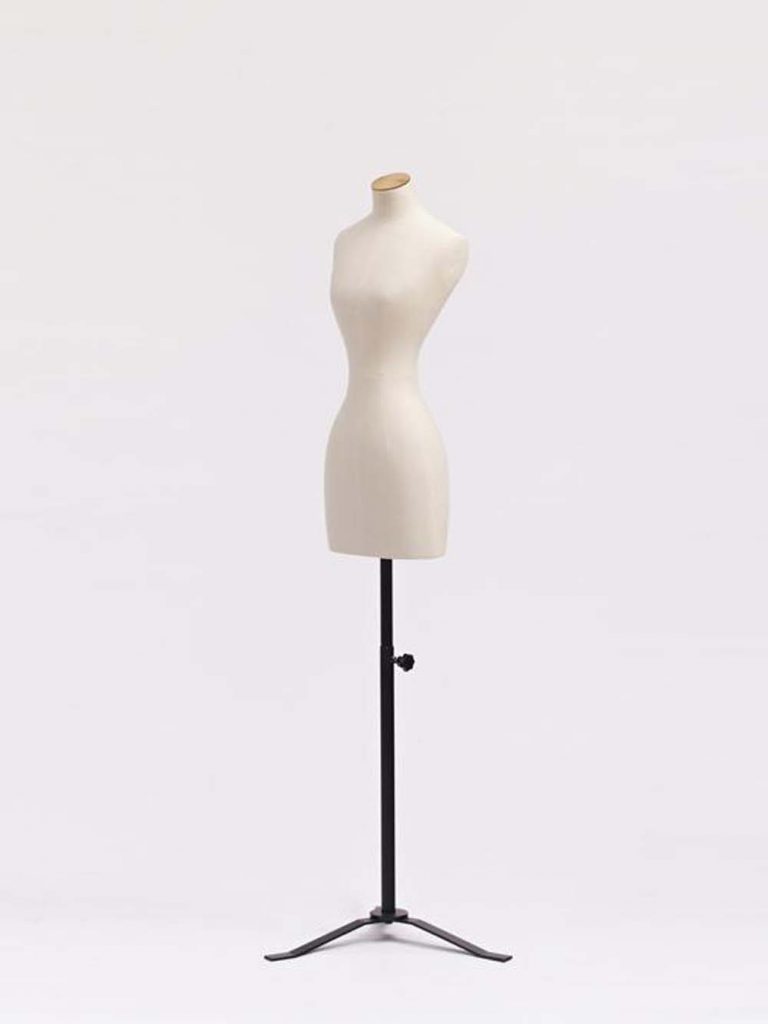
The mannequin
The final piece of work was to adapt a custom bought figure to fit the mantua. Changing the shape of a mannequin can be quite challenging due to the wide variety of dress styles and shapes in historical clothing. I was using a special figure developed by the V&A with Proportion London which is intended for use with 18th century clothing. The bust is lower than on standard figures today, and the torso is slightly shaped to create the profile of the stays or corset worn at that time. The mannequin waist was smaller than the petticoat by several inches, but it was much better to build it up than use a bigger sized figure and attempt to reduce the shoulder measurement.

I used Plastazote®, an inert polyethylene foam, and applied it in strips to the figure. The foam was further cut and shaped to form the 18th century stays profile using a hot melt cutting tool. I covered the torso with a skim of polyester wadding and jersey, and then added a top cover of peach coloured silk jersey, as the Mantua silk is so fine that all other colours, including white, would show through.
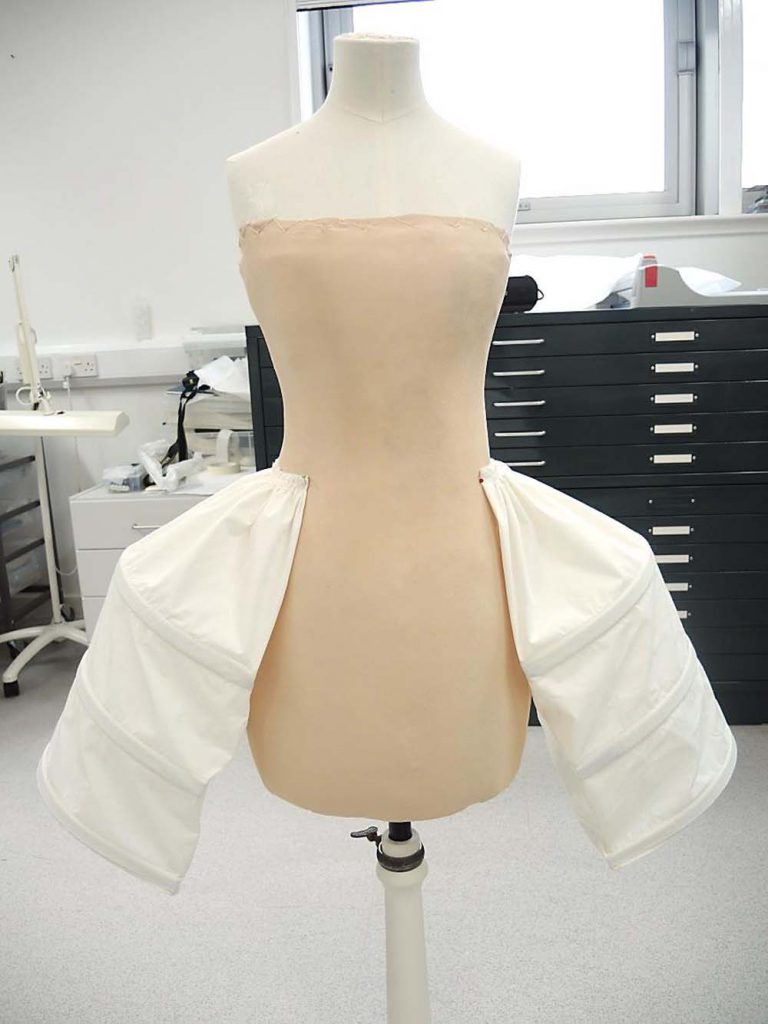
I also made some side panniers and sewed them to the figure. They can be tied on with a waist band as they would have been in wear, but they are prone to moving around whilst the figure is being dressed. Dressing the mannequin is a delicate part of the process, and securing undergarments first helps to minimise handling and movement of the historic silk.
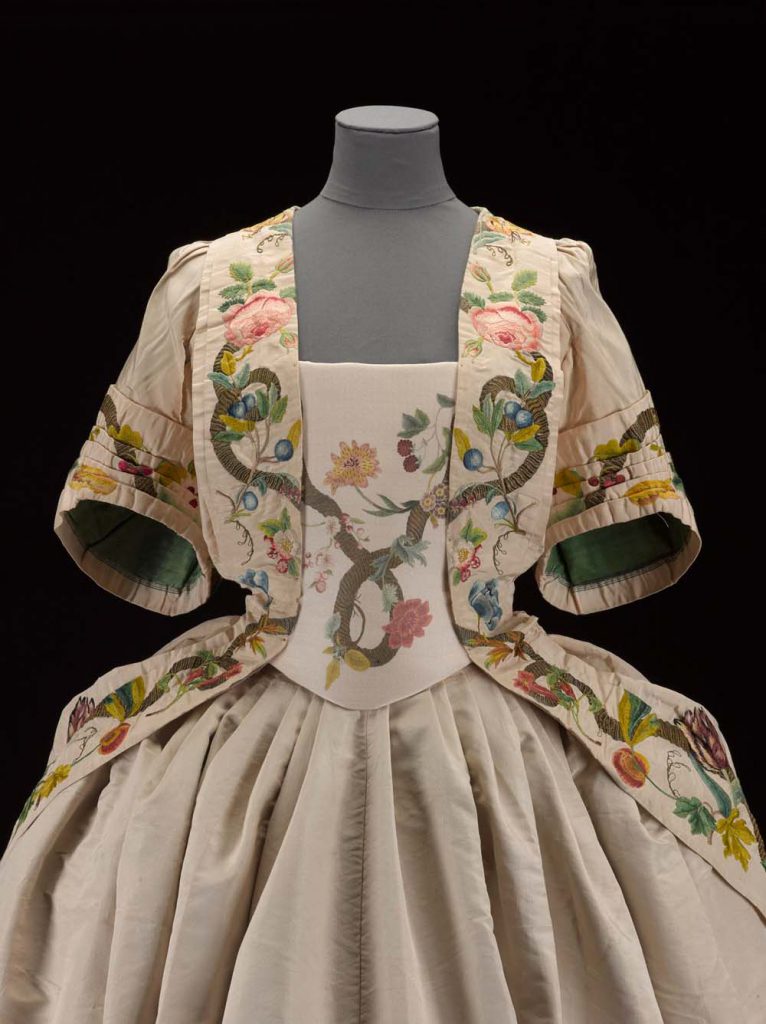
The Oliphant Mantua was ready to go on display. It took approximately 170 hours to conserve and mount, but with such a beautiful and interesting object, was always satisfying to work on.




